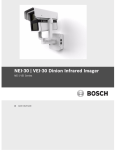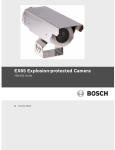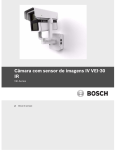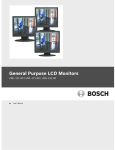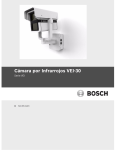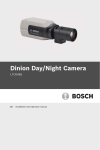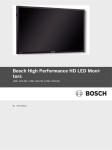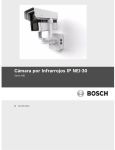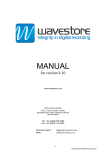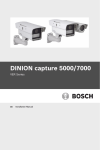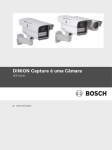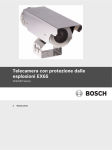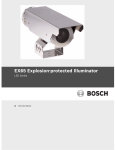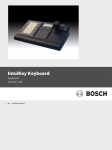Download Bosch VEI-30 Installation manual
Transcript
VEI-30 Dinion Infrared Imager VEI-Series en Installation Manual VEI-30 Dinion Infrared Imager Table of Contents | en 3 Table of Contents 1 Safety 5 1.1 Safety precautions 5 1.2 Important notices 5 1.3 FCC & ICES compliance 8 1.4 CSA certification 9 1.5 Bosch notices 9 2 Description 10 2.1 Unpacking 10 2.2 Parts List 10 2.2.1 Parts Included with the Product 10 2.2.2 User-supplied Parts 10 3 Planning 11 3.1 Hardware Requirements 11 3.2 Pre-installation Checklist 12 4 Installation 13 4.1 Mount the Junction Box 13 4.2 Route Wires and Attach Connectors 14 4.3 Attach Pendant Arm to Junction Box 15 5 Connection 16 5.1 Power Connection 16 5.2 Video and Control Cables 16 5.3 Alarm Output Connections 17 6 Configuration 18 6.1 Accessing the Controls 18 6.2 Adjusting the Focus and Focal Length 19 6.3 Making Pan Adjustments 20 6.4 Making Tilt Adjustments 20 6.5 Adjusting the Variable Field Illumination 21 6.5.1 Adjusting the LED Tilt Angle 21 6.5.2 Adjusting the Illumination Beam Width 21 Bosch Security Systems, Inc. Installation Manual F.01U.166.250 | 1.0 | 2011.04 4 en | Table of Contents 7 VEI-30 Dinion Infrared Imager Operation 23 7.1 Menus 23 7.1.1 Top level menus 23 7.1.2 Menu navigation 23 7.2 Pre-defined modes 24 7.3 Camera control communication (Bilinx) 24 7.4 Main menu structure 25 7.4.1 Mode submenu 25 7.4.2 ALC submenu 25 7.4.3 Shutter/AGC submenu 26 7.4.4 Day/Night submenu 27 7.4.5 Illuminator submenu 28 7.4.6 Enhance / Dynamic Engine submenu 28 7.4.7 Color submenu 29 7.4.8 VMD submenu 30 7.5 Install menu structure 31 7.5.1 Lens Wizard submenu 31 7.5.2 Language submenu 32 7.5.3 Privacy Masking submenu 32 7.5.4 Synchronization submenu 32 7.5.5 Alarm Output submenu 33 7.5.6 Connections submenu 33 7.5.7 Test Signals submenu 33 7.5.8 Camera ID submenu 34 7.5.9 Defaults submenu 34 8 Maintenance 35 8.1 Repairs 35 8.2 Transfer and Disposal 35 9 Technical Data 36 Index 38 F.01U.166.250 | 1.0 | 2011.04 Installation Manual Bosch Security Systems, Inc. VEI-30 Dinion Infrared Imager Safety | en 1 Safety 1.1 Safety precautions 5 DANGER! High risk: This symbol indicates an imminently hazardous situation such as “Dangerous Voltage” inside the product. If not avoided, this will result in an electrical shock, serious bodily injury, or death. WARNING! Medium risk: Indicates a potentially hazardous situation. If not avoided, this could result in minor or moderate bodily injury. CAUTION! Low risk: Indicates a potentially hazardous situation. If not avoided, this could result in property damage or risk of damage to the unit. 1.2 Important notices Accessories - Do not place this unit on an unstable stand, tripod, bracket, or mount. The unit may fall, causing serious injury and/or serious damage to the unit. Use only with the cart, stand, tripod, bracket, or table specified by the manufacturer. When a cart is used, use caution and care when moving the cart/apparatus combination to avoid injury from tip-over. Quick stops, excessive force, or uneven surfaces may cause the cart/unit combination to overturn. Mount the unit per the manufacturer's instructions. All-pole power switch - Incorporate an all-pole power switch, with a contact separation of at least 3 mm in each pole, into the electrical installation of the building. If it is needed to open the housing for servicing and/or other activities, use this all-pole switch as the main disconnect device for switching off the voltage to the unit. Camera grounding - For mounting the camera in potentially damp environments, ensure to ground the system using the ground connection of the power supply connector (see section: Connecting external power supply). Camera lens - An assembled camera lens in the outdoor housing must comply and be tested in accordance with UL/IEC60950. Any output or signal lines from the camera must be SELV or Limited Power Source. For safety reasons the environmental specification of the camera lens assembly must be within the environmental specification of -10 °C to 50 °C (14 °F to 122 °F). Camera signal - Protect the cable with a primary protector if the camera signal is beyond 140 feet, in accordance with NEC800 (CEC Section 60). CAUTION! CLASS 1 LED PRODUCT IEC60825-1 Ed. 1.2 (2001) Bosch Security Systems, Inc. Installation Manual F.01U.166.250 | 1.0 | 2011.04 6 en | Safety VEI-30 Dinion Infrared Imager Coax grounding: – – Ground the cable system if connecting an outside cable system to the unit. Connect outdoor equipment to the unit's inputs only after this unit has had its grounding plug connected to a grounded outlet or its ground terminal is properly connected to a ground source. – Disconnect the unit's input connectors from outdoor equipment before disconnecting the grounding plug or grounding terminal. – Follow proper safety precautions such as grounding for any outdoor device connected to this unit. U.S.A. models only - Section 810 of the National Electrical Code, ANSI/NFPA No.70, provides information regarding proper grounding of the mount and supporting structure, grounding of the coax to a discharge unit, size of grounding conductors, location of discharge unit, connection to grounding electrodes, and requirements for the grounding electrode. Disposal - Your Bosch product was developed and manufactured with high-quality material and components that can be recycled and reused. This symbol means that electronic and electrical appliances, which have reached the end of their working life, must be collected and disposed of separately from household waste material. Separate collecting systems are usually in place for disused electronic and electrical products. Please dispose of these units at an environmentally compatible recycling facility, per European Directive 2002/96/EC. Electronic Surveillance - This device is intended for use in public areas only. U.S. federal law strictly prohibits surreptitious recording of oral communications. Environmental statement - Bosch has a strong commitment towards the environment. This unit has been designed to respect the environment as much as possible. Electrostatic-sensitive device - Use proper CMOS/MOS-FET handling precautions to avoid electrostatic discharge. NOTE: Wear required grounded wrist straps and observe proper ESD safety precautions when handling the electrostatic-sensitive printed circuit boards. Fuse rating - For protection of the device, the branch circuit protection must be secured with a maximum fuse rating of 16A. This must be in accordance with NEC800 (CEC Section 60). Grounding and polarization - This unit may be equipped with a polarized alternating current line plug (a plug with one blade wider than the other blade). This safety feature allows the plug to fit into the power outlet in only one way. If unable to insert the plug fully into the outlet, contact a locally certified electrician to replace the obsolete outlet. Do not defeat the safety purpose of the polarized plug. Alternately, this unit may be equipped with a 3-pole grounding plug (a plug with a third pin for earth grounding). This safety feature allows the plug to fit into a grounded power outlet only. If unable to insert the plug into the outlet, contact a locally certified electrician to replace the obsolete outlet. Do not defeat the safety purpose of the grounding plug. Moving - Disconnect the power before moving the unit. Move the unit with care. Excessive force or shock may damage the unit and the hard disk drives. Outdoor signals - The installation for outdoor signals, especially regarding clearance from power and lightning conductors and transient protection, must be in accordance with NEC725 and NEC800 (CEC Rule 16-224 and CEC Section 60). Permanently connected equipment - Incorporate a readily accessible disconnect device external to the equipment. Pluggable equipment - Install the socket outlet near the equipment so it is easily accessible. Power resupply - If the unit is forced to power down due to exceeding the specified operating temperatures, disconnect the power cord, wait for at least 30 seconds, and then reconnect the power cord. F.01U.166.250 | 1.0 | 2011.04 Installation Manual Bosch Security Systems, Inc. VEI-30 Dinion Infrared Imager Safety | en 7 Power lines - Do not locate the camera near overhead power lines, power circuits, or electrical lights, nor where it may contact such power lines, circuits, or lights. SELV - All the input/output ports are Safety Extra Low Voltage (SELV) circuits. SELV circuits should only be connected to other SELV circuits. Because the ISDN circuits are treated like telephone-network voltage, avoid connecting the SELV circuit to the Telephone Network Voltage (TNV) circuits. System ground/Safety ground System (video) ground is indicated by the symbol Safety (power) ground is indicated by the symbol . . The system ground is only used to comply with safety standards or installation practices in certain countries. Bosch does not recommend connecting system ground to safety ground unless it is explicitly required. However, if the system ground and safety ground are connected and grounding loops are causing interference in the video signal, use an isolation transformer (available separately from Bosch). CAUTION! Connecting System ground to Safety ground may result in ground loops that can disrupt the CCTV system. Video loss - Video loss is inherent to digital video recording; therefore, Bosch Security Systems cannot be held liable for any damage that results from missing video information. To minimize the risk of lost digital information, Bosch Security Systems recommends multiple, redundant recording systems, and a procedure to back up all analog and digital information. Bosch Security Systems, Inc. Installation Manual F.01U.166.250 | 1.0 | 2011.04 8 1.3 en | Safety VEI-30 Dinion Infrared Imager FCC & ICES compliance FCC Information (U.S.A. and Canadian Models Only) This equipment has been tested and found to comply with the limits for a Class B digital device, pursuant to part 15 of the FCC Rules. These limits are designed to provide reasonable protection against harmful interference in a residential installation. This equipment generates, uses, and can radiate radio frequency energy and, if not installed and used in accordance with the instructions, may cause harmful interference to radio communications. However, there is no guarantee that interference will not occur in a particular installation. If this equipment does cause harmful interference to radio or television reception, which can be determined by turning the equipment off and on, the user is encouraged to try to correct the interference by one or more of the following measures: – reorient or relocate the receiving antenna; – increase the separation between the equipment and receiver; – connect the equipment into an outlet on a circuit different from that to which the receiver is connected; – consult the dealer or an experienced radio/TV technician for help. Intentional or unintentional modifications, not expressly approved by the party responsible for compliance, shall not be made. Any such modifications could void the user's authority to operate the equipment. If necessary, the user should consult the dealer or an experienced radio/television technician for corrective action. The user may find the following booklet, prepared by the Federal Communications Commission, helpful: How to Identify and Resolve Radio-TV Interference Problems. This booklet is available from the U.S. Government Printing Office, Washington, DC 20402, Stock No. 004000-00345-4. Informations FCC et ICES (modèles utilisés aux États-Unis et au Canada uniquement) Suite à différents tests, cet appareil s'est révélé conforme aux exigences imposées aux appareils numériques de classe B, en vertu de la section 15 du règlement de la Commission fédérale des communications des États-Unis (FCC), et en vertu de la norme ICES-003 d'Industrie Canada. Ces exigences visent à fournir une protection raisonnable contre les interférences nuisibles lorsque l'appareil est utilisé dans le cadre d'une installation résidentielle. Cet appareil génère, utilise et émet de l'énergie de radiofréquences et peut, en cas d'installation ou d'utilisation non conforme aux instructions, engendrer des interférences nuisibles au niveau des radiocommunications. Toutefois, rien ne garantit l'absence d'interférences dans une installation particulière. Il est possible de déterminer la production d'interférences en mettant l'appareil successivement hors et sous tension, tout en contrôlant la réception radio ou télévision. L'utilisateur peut parvenir à éliminer les interférences éventuelles en prenant une ou plusieurs des mesures suivantes: – Modifier l'orientation ou l'emplacement de l'antenne réceptrice; – Éloigner l'appareil du récepteur; – Brancher l'appareil sur une prise située sur un circuit différent de celui du récepteur; – Consulter le revendeur ou un technicien qualifié en radio/télévision pour obtenir de l'aide. Toute modification apportée au produit, non expressément approuvée par la partie responsable de l'appareil, est strictement interdite. Une telle modification est susceptible d'entraîner la révocation du droit d'utilisation de l'appareil. La brochure suivante, publiée par la Commission fédérale des communications (FCC), peut s'avérer utile : How to Identify and Resolve Radio-TV Interference Problems (Comment identifier F.01U.166.250 | 1.0 | 2011.04 Installation Manual Bosch Security Systems, Inc. VEI-30 Dinion Infrared Imager Safety | en 9 et résoudre les problèmes d’interférences de radio et de télévision). Cette brochure est disponible auprès du U.S. Government Printing Office, Washington, DC 20402, États-Unis, sous la référence n° 004-000-00345-4. NOTICE! This is a class B product. In a domestic environment this product may cause radio interference, in which case the user may be required to take adequate measures. 1.4 CSA certification Disclaimer CSA has not tested the performance or reliability of the security or signaling aspects of this product. CSA has only tested fire, shock and/or casualty hazards as outlined in CSA's Standard(s) for Safety for Closed Circuit Television Equipment, UL 2044. CSA Certification does not cover the performance or reliability of the security or signaling aspects of this product. CSA MAKES NO REPRESENTATIONS, WARRANTIES, OR CERTIFICATIONS WHATSOEVER REGARDING THE PERFORMANCE OR RELIABILITY OF ANY SECURITY OR SIGNALING RELATED FUNCTIONS OF THIS PRODUCT. Disclaimer CSA has not tested the performance or reliability of the security or signaling aspects of this product. CSA has only tested fire, shock and/or casualty hazards as outlined in CSA's Standard(s) for Safety for Information Technology Equipment, UL 60950-1. CSA Certification does not cover the performance or reliability of the security or signaling aspects of this product. CSA MAKES NO REPRESENTATIONS, WARRANTIES, OR CERTIFICATIONS WHATSOEVER REGARDING THE PERFORMANCE OR RELIABILITY OF ANY SECURITY OR SIGNALINGRELATED FUNCTIONS OF THIS PRODUCT. 1.5 Bosch notices Copyright This manual is the intellectual property of Bosch Security Systems and is protected by copyright. All rights reserved. Trademarks All hardware and software product names used in this document are likely to be registered trademarks and must be treated accordingly. NOTE: This manual has been compiled with great care and the information it contains has been thoroughly verified. The text was complete and correct at the time of printing. The ongoing development of the products may mean that the content of the user guide can change without notice. Bosch Security Systems accepts no liability for damage resulting directly or indirectly from faults, incompleteness or discrepancies between the user guide and the product described. More information For more information, please contact the nearest Bosch Security Systems location or visitwww.boschsecurity.com Bosch Security Systems, Inc. Installation Manual F.01U.166.250 | 1.0 | 2011.04 10 en | Description 2 VEI-30 Dinion Infrared Imager Description The VEI-30 IR Imager is a high-performance, CCD-based day/night analog camera and built-in infrared illuminator, with outdoor, all-weather housing and bracketry (rated to IP67). The VEI-30 is easy to install and ready to use, and offers the best solution for demanding scene conditions. Features include: 2.1 – True Day/Night performance with switchable IR filter and Auto Photocell switching mode – Illuminator with variable field illumination – Progressive scan – 540 TVL resolution – Dynamic engine with Smart BLC – Privacy masks – Bilinx (bi-directional coaxial communication) – Wide operating temperature range (–40°C to +50°C / –40°F to +122°F) – Six pre-programmed operation modes – Adaptive dynamic noise reduction – Multiple language on-screen display Unpacking This electronic equipment should be unpacked and handled carefully. If an item appears to have been damaged in shipment, notify the shipper immediately. Verify that all the parts listed in the Parts List below are included. If any items are missing, notify your Bosch Security Systems Sales or Customer Service Representative. The original packing carton is the safest container in which to transport the unit and must be used if returning the unit for service. Save it for possible future use. 2.2 Parts List 2.2.1 Parts Included with the Product Quantity Item 2.2.2 1 VEI-30 IR Imager camera 1 Cable-managed pan/tilt bracket 1 Junction box 1 Sunshield 1 3D Diffuser 1 Hex key set (consisting of 1x 5 mm hex key; 1x 4 mm hex key 1 Corner mount kit (optional) 1 Mast mount kit (optional) 1 Quick Install Guide User-supplied Parts Quantity Item 4 Lag bolts, 1/4-9 x 2 (M7-0.35 x 50) with 1/2 in. head 4 1/2 in. (12 mm) washers 2 3/4 in. (20 mm) NPS watertight pipe fittings OR 1/2 in. (15 mm) NPS watertight pipe fittings F.01U.166.250 | 1.0 | 2011.04 Installation Manual Bosch Security Systems, Inc. VEI-30 Dinion Infrared Imager 3 Planning | en 11 Planning CAUTION! CLASS 1 LED PRODUCT IEC60825-1 Ed. 1.2 (2001) WARNING! IMPORTANT MOUNTING INSTRUCTIONS This apparatus must be securely attached to the wall in accordance with these installation instructions. Failure to follow installation instructions may result in injury or death. CAUTION! Ensure that the selected location is protected from falling objects, accidental contact with moving objects, and unintentional interference from personnel. Follow all applicable building codes. Select a suitable location that protects the camera from accidental damage, tampering and environmental conditions exceeding the specifications of the camera. Follow these mounting guidelines: 1. Locate the camera such that it cannot be easily interfered with, either intentionally or accidentally. 2. Select a smooth, flat mounting surface to ensure proper sealing. The surface must also support the combined weight of the camera and mounting hardware under all expected conditions of vibration and temperature. Recommended mounting height is at least 4 m (13 ft); however, optimal conditions will vary with the specific installation environment. 3.1 Hardware Requirements Tools Required – 1x 5 mm (3/16) hex key; 1x 4 mm (5/32) hex key (supplied) – Small, straight-blade screwdriver - 2.5 mm (0.1 in.) – Socket wrench and 9/16 in. (14 mm) socket – Drill and 7/32 in. (5.5mm) drill bit Hardware Requirements – VEI-30 or NEI-30 junction box – Four (4) lag bolts, 1/4-9 x 2 (M7-0.35 x 50) with 1/2 in. head (not supplied) – Four (4) 1/2 in. (12 mm) washers (not supplied) – Two (2) 3/4 in. (20 mm) NPS watertight pipe fittings OR 1/2 in. (15 mm) NPS watertight pipe fittings (not supplied) Bosch Security Systems, Inc. Installation Manual F.01U.166.250 | 1.0 | 2011.04 12 3.2 en | Planning VEI-30 Dinion Infrared Imager Pre-installation Checklist WARNING! This installation must be made by a qualified service person and must conform to all local codes. WARNING! CSA Certified / UL Listed CLASS 2 power adaptors must be used in order to comply with electrical safety standards. 1. Determine the location and distance for the junction box based on its voltage and current consumption. See Section 5 Connection, page 16, for wiring information and distances. 2. Use only UL-listed liquid tight strain reliefs for conduits to the junction box to ensure that water cannot enter the box. You must use 3/4 in. (20 mm) NPS watertight conduits and fittings (to meet NEMA 4X standards). WARNING! Power and I/O cabling must be routed separately inside different permanently earthed metal conduits. 3. Route all rough wiring including: power, control, video coax, alarms I/O, relay I/O, and fiber optic cabling. See Section 5 Connection, page 16, for video and control protocol methods. WARNING! Install external interconnecting cables in accordance with NEC, ANSI/NFPA70 (for US application) and Canadian Electrical Code, Part I, CSA C22.1 (for CAN application) and in accordance with local country codes for all other countries. CSA Certified / UL Listed CLASS 2 power adaptors must be used in order to comply with electrical safety standards. Branch circuit protection incorporating a 20 A, 2-pole Listed Circuit Breaker or Branch Rated Fuses are required as part of the building installation. A readily-accessible 2-pole disconnect device with a contact separation of at least 3 mm must be incorporated. 4. Select the appropriate mounting kit to use, depending on the location of the VEI-30 / NEI30 Series camera. The camera is intended to be mounted securely to a wall using the mounting holes in the junction box. CAUTION! Select a rigid mounting location to prevent excessive vibration to the camera. F.01U.166.250 | 1.0 | 2011.04 Installation Manual Bosch Security Systems, Inc. VEI-30 Dinion Infrared Imager 4 Installation | en 13 Installation This chapter details how to mount the VEI-30 / NEI-30 to a wall. Any variations to the installation procedures are noted. 4.1 Mount the Junction Box Before mounting the junction box, decide if you should wire the box through the holes in the bottom or back of the box. If wiring the box through the back, move the two (2) seal plugs to the bottom through-holes before mounting. This installation must be made by a qualified service person and must conform to all local codes. NOTICE! Use 3/4 in. (20 mm) NPS fittings for the holes on the bottom and back of the box. Use 1/2 in. (15 mm) NPS fittings for the side holes. Figure 4.1 Junction Box Wall Mount WARNING! The camera has been evaluated for wall mounting using the following hardware secured into a 2 x 4 stud under 1/2 in. drywall: – Four (4) Lag bolts, 1/4-9 x 2 (M7-0.35 x 50) with 1/2 in. head – Four (4) 1/2 in. (12 mm) flat washers Bosch Security Systems, Inc. Installation Manual F.01U.166.250 | 1.0 | 2011.04 14 en | Installation VEI-30 Dinion Infrared Imager 1. Locate a stud in the wall and mark the outside edges of the stud. 2. Using the wall mount bracket as a template, align the mounting hole with the center of the stud. 3. Mark the point on the wall in the center of the hole where the mounting bolt will be positioned. 4. Remove the wall mount bracket and drill a pilot hole at the marked point. 5. Align the wall mount bracket mounting hole with the hole drilled in the wall. 6. Using a 9/16 in. (14 mm) socket and driver, secure the wall mount bracket by screwing the 1/4-9 x 2 (M7-0.35 x 50) lag bolt with 1/2 in. (12 mm) washer securely into the stud. 7. 8. Follow this procedure to attach the three remaining lag bolts. Attach 3/4 in. (20 mm) NPS watertight pipe fittings (not supplied) to the bottom or back holes of the junction box through which you will run the power, video, and control data wires. NOTICE! The camera has not been evaluated for safety requirements using other mounting kits. 4.2 Route Wires and Attach Connectors Power wires must be routed to the right (front) side of the junction box through a separate conduit. All video, control, and alarm wires must be routed through a second conduit to the left side of the box. WARNING! External interconnecting cables are to be installed in accordance with NEC, ANSI/NFPA70 (for US application) and Canadian Electrical Code, Part I, CSA C22.1 (for CAN application) and in accordance with local country codes for all other countries. 1. Route all video, control, and alarm wires through the conduit fitting on the left side of the junction box. See Section 5 Connection, page 16 for coax, UTP, and fiber optic specifications and distances. 2. Route the 24 VAC / 12 VDC lines through the conduit fitting on the right side of the box. 3. Cut and trim all wires with sufficient slack to reach their connector terminals in the box, but not so long as to be pinched. See Figure 4.2, Page 15, above, for the connector locations. 4. Attach the supplied 2-pin Power Plug to the incoming power wires. 5. Attach the supplied 7-pin relay output plug to the incoming relay wires. 6. Attach a BNC connector to the incoming video coax cable. If using UTP for video or installing an Ethernet model, attach an RJ45 plug to the incoming UTP cable. If installing a Fiber Optic model, attach an ST fiber plug to the fiber optic cable. See Section 5 Connection, page 16, for the different methods of transmitting video and for wire specifications. F.01U.166.250 | 1.0 | 2011.04 Installation Manual Bosch Security Systems, Inc. VEI-30 Dinion Infrared Imager 4.3 Installation | en 15 Attach Pendant Arm to Junction Box The bottom hinge pin of the Camera Arm is provided with a Hinge Pin Stop to hold the hinge open while attaching the arm to the junction box. 1. Compress the bottom hinge pin by pushing the pin lever downward and rotating it behind the Hinge Pin Stop. Figure 4.2 Camera Box Hinge Alignment 2. Open the top hinge by pushing its pin lever up and holding it. NOTICE! Both Hinge Pins must be fully compressed to open (unlock) the hinges of the Camera Arm and before proceeding to the next step. 3. While continuing to hold the top hinge pin, open and align the top and bottom hinges of the Camera Arm to their mating points on the junction box. See Figure 4.2, above, for an illustration. 4. Once you have aligned the hinges, release the top hinge pin to engage its mating hinge on the junction box. Then release the bottom hinge pin from the Hinge Pin Stop to lock the Camera Arm to the junction box. WARNING! Serious injury or death can occur if the hinge pins of the Camera Arm are not fully engaged (locked) to the junction box. Exercise caution before releasing the Camera Arm. Bosch Security Systems, Inc. Installation Manual F.01U.166.250 | 1.0 | 2011.04 16 en | Connection VEI-30 Dinion Infrared Imager 5 Connection 5.1 Power Connection Connect power from a 12 VDC or 24 VAC class 2 power supply as follows: – Use AWG 16 to 22 stranded wire or AWG 16 to 26 solid wire; cut back 5 mm (0.2 in.) of insulation. – Loosen the screws of the supplied 2-pole connector and insert the wires. – Tighten the screws and insert the 2-pole connector into the power socket of the camera. If the input voltage is not within the required range, the voltage indicator LED (on the front face) will flash. NOTICE! For a DC supply, the polarity is important. Incorrect polarity does not damage the camera, but will not allow the camera to switch on. If input voltage is not within the specified range or has incorrect polarity (DC only), a yellow LED indicator in the front window pulses to indicate this condition. 5.2 Video and Control Cables Coaxial Cable Coaxial cable terminated with BNC connectors is the most common method for transmitting composite video. Bilinx control data can also be sent over the same cable. Bilinx is a Bosch 2way communication protocol that allows remote control, configuration, and updates over a video coax cable. Bilinx is available on all analog models. VEI-30 models feature cable compensation or “Pre-Comp,” which extends the range of video from the head end, but does not extend the range of Bilinx control (n/a on NEI-30 models). Cable Compensation Maximum Distances Video Only Bilinx Control Cable Type Pre-comp OFF Pre-comp ON Pre-comp ON or OFF RG-59/U 300 m (1000 ft) 600 m (2000 ft) 300 m (1000 ft) RG-6/U 450 m (1500 ft) 900 m (3000 ft) 450 m (1500 ft) RG-11/U 600 m (2000 ft) 1200 m (4000 ft) 600 m (2000 ft) Size O.D. between 4.6 mm to 7.9 mm (0.181 in. to 0.312 in.) Shield Copper braid: 95% Central Conductor Standard copper center Terminal Connector BNC F.01U.166.250 | 1.0 | 2011.04 Installation Manual Bosch Security Systems, Inc. VEI-30 Dinion Infrared Imager 5.3 Connection | en 17 Alarm Output Connections Figure 5.1 Terminal Block for Alarm Output Connections # Label Description Wire Color Connects To... 1 D1 Illuminator on alarm output connection 1 Black Pin 1 of terminal block CN10 Illuminator on alarm output connection 2 Orange on single channel Pin 2 of terminal block CN10 Voltage free and either open (Illuminator on single channel 3 T1 off mode) or closed (Illuminator on mode) Tamper alarm output connection 1 Brown Pin 1 of terminal block CN11 4 T2 Tamper alarm output connection 2 2 D2 Gray on single channel Pin 2 of terminal block Cn11 on single channel Voltage free and either open or closed 5 V1 (normally closed) Camera alarm output connection 1 White Pin 6 of terminal block X453 6 V2 Camera alarm output connection 2 Yellow on processor PCBA Pin 3 of terminal block X453 7 NC Not connected (not on processor PCBA connected) Bosch Security Systems, Inc. Installation Manual F.01U.166.250 | 1.0 | 2011.04 18 6 en | Configuration VEI-30 Dinion Infrared Imager Configuration All VEI-30 camera settings (except lens focus, focal length, and LED tilt) can be adjusted remotely using the Configuration Tool for Imaging Devices (CTFID) software application. Refer to the Configuration Tool for Imaging Devices User Manual located on the Bosch Security Systems website (www.boschsecurity.com). To adjust the focal length, focus, and the LED tilt, use the controls located on the access panel on the rear of the camera housing. An access panel also contains the camera keypad buttons that you use to interact with the camera’s on-screen display (OSD) menu. This menu provides advanced set-up options for getting the best results under special circumstances. 6.1 Accessing the Controls 1. Unscrew the two (2) captive screws (item 1, below) of the access panel on the rear of the camera housing. 2. Remove the sealing plug on the bottom left corner. 3. Open the access panel. Now you can adjust the focus, focal length, and LED tilt controls Figure 6.1 Rear camera housing with access panel (see Figure 6.2 below). Note: Before you make any adjustments, you may need to connect the camera to a monitor to view the changes to the picture. See Section 5 Connection, page 16 for details. Refer to the complete installation manual (on CD) for details about advanced camera setup using the keypad controls. NOTICE! Remember to replace the sealing plug and tighten the captive screws on the panel when you finish the adjustments. F.01U.166.250 | 1.0 | 2011.04 Installation Manual Bosch Security Systems, Inc. VEI-30 Dinion Infrared Imager Configuration | en 19 Figure 6.2 Camera and LED 1 2 3 4 6.2 Focal length adjustment Focus adjustment (zoom) Advanced camera setup controls - keypad LED tilt control Adjusting the Focus and Focal Length 1. 2. Use the top set screw (item 1, Figure 6.2) to adjust the image focus: – Turn the set screw to the left to focus toward (N) (near) (zoom in). – Turn the set screw to the right to focus toward (F) (far) (zoom out). Use the lower set screw (item 2, Figure 6.2) to adjust the focal length (tight or wide): – Turn the set screw to the left for a wider focal length – Turn the set screw to the right for a telephoto (tight) focal length. Figure 6.3 Focus and Zoom graphic on the inside of the access panel on the rear of the camera housing. Bosch Security Systems, Inc. Installation Manual F.01U.166.250 | 1.0 | 2011.04 20 6.3 en | Configuration VEI-30 Dinion Infrared Imager Making Pan Adjustments 1. Using the 4 mm hex key, loosen the bolts at the base of the “u bracket” to make the necessary pan adjustments. 6.4 2. When loosened, adjust the camera to the desired pan angle. 3. Tighten the bolt to secure in place. Making Tilt Adjustments 1. Unscrew the round caps (CCW) where the bracket attaches to the camera housing to expose the bolts for tilt adjustment. 2. Using the 4 mm hex key, loosen the bolts and make the necessary tilt adjustments. 3. Tighten the bolts to secure the camera in place. 4. Replace the round caps when you finish the adjustments. F.01U.166.250 | 1.0 | 2011.04 Figure 6.4 Example orientation: Camera rotated 90 degrees left, pointing up 50 degrees Figure 6.5 Example orientation: Camera rotated 90 degrees right, pointing down 50 degrees Installation Manual Bosch Security Systems, Inc. VEI-30 Dinion Infrared Imager Configuration | en 6.5 Adjusting the Variable Field Illumination 6.5.1 Adjusting the LED Tilt Angle 21 You can orient the LED array tilted either up or down to maximize infrared coverage over the field of view. On the rear of the camera housing is graphic for the LED tilt. Figure 6.6 LED tilt scale The “+” symbol indicates adjusting the LED tilt angle above the camera axis; and the “-” symbol indicates adjusting the LED tilt angle below the camera axis. As a general guideline, when the camera is pointed at a steeper angle down (usually at higher installation heights or for shorter range applications), the LED tilt angle should be raised above the camera axis to reduce the potential of overexposure in the foreground. 6.5.2 Adjusting the Illumination Beam Width You can adjust the infrared beam width by adding or removing the 3D diffuser. The 3D diffuser is recommended for wider field of view applications. With the 3D diffuser, a focal length of 6 mm provides a horizontal field of view of 43° to match the illumination pattern; the resulting beam angle is 43° (H) x 10° (V). Without the 3D diffuser, a focal length of 27 mm (or greater) provides a horizontal field of view of 10° (or less) to match the illumination pattern; the resulting beam angle is 10° (H) x 10° (V). Each camera ships a 3D diffuser plate (already installed in the camera.) and the 3D diffuser (not installed in the camera). When inserted, the 3D diffuser will be held in place by the diffuser plate. To install the 3D diffuser: 1. Unscrew the four (4) captive screws beneath the illuminator in the front of the unit (circled in Figure 6.7, below). Figure 6.7 3D Diffuser (area circled) 2. Using the captive screws, remove the 3D diffuser plate. 3. Insert the 3D diffuser into the slit in the gasket on the 3D diffuser plate. IMPORTANT: Ensure that the diffuser is inserted into the camera housing with the sticker side facing the LED array. It is important that the diffuser is oriented with the sticker side surface facing the LED array or IR performance will be lost. 4. Install the diffuser and plate assembly into the camera housing to secure and seal the unit. Bosch Security Systems, Inc. Installation Manual F.01U.166.250 | 1.0 | 2011.04 22 en | Configuration VEI-30 Dinion Infrared Imager To remove the 3D diffuser: 1. Remove the 3D diffuser and plate assembly as when installing the 3D diffuser. 2. Remove the 3D diffuser from the diffuser plate. 3. Install the diffuser plate into the camera housing to secure and seal the unit. F.01U.166.250 | 1.0 | 2011.04 Installation Manual Bosch Security Systems, Inc. VEI-30 Dinion Infrared Imager 7 Operation | en 23 Operation The camera normally provides an optimal picture without the need for further adjustments. Advanced set-up options are available in a menu system for getting the best results under special circumstances. The camera implements your changes immediately so that before and after settings are easily compared. 7.1 Menus 7.1.1 Top level menus Once you have opened the access panel on the rear of the camera housing (see Section 7, Configuration), you can adjust the camera settings via the camera’s on-screen display (OSD) menus. There are two upper-level menus: the Main menu and the Install menu. The menus have functions that can be selected directly or submenus for more detailed set-up. – To access the Main menu, press the menu/select button (center) for less than 1 second. The Main menu appears on the monitor. The Main menu allows you to select and set up the picture enhancement functions. If you are not happy with your changes, you can always recall the default values for the mode. – The camera also has an Install menu in which the installation settings can be set. To access the Install menu, press the menu/select button (center) for longer than 2 seconds. 7.1.2 Menu navigation Five keys, located behind the access panel on the back of the camera, are used for navigating through the menu system. Figure 7.1 Key 1 2 3 4 5 Advanced camera setup keypad Description Up key Right key Down key Left key Menu/Select key – Use the up or down keys to scroll through a menu. – Use the left or right keys to move through options or to set parameters. – When in a menu, quickly double-press the menu/select key to restore the selected item to its factory default. – To close all menus at once, hold down the menu/select key until the menu display disappears or continually select the Exit item. Some menus close automatically after about two minutes; other menus must be closed manually. Bosch Security Systems, Inc. Installation Manual F.01U.166.250 | 1.0 | 2011.04 24 7.2 en | Operation VEI-30 Dinion Infrared Imager Pre-defined modes There are six pre-defined modes with settings to make configuration easier. You can select one of the six pre-defined modes in the Install/Mode submenu. The modes are defined as follows: 1. 24-hour Default installation mode to provide stable pictures over a 24-hour period. These settings are optimized for out-of-the-box installation. 2. Traffic Capture high-speed objects using default shutter in variable lighting conditions. 3. Low light Provide extra enhancement such as AGC and SensUp to make usable pictures in low-light conditions. 4. Smart BLC Settings optimized to capture details in high contrast and extremely bright-dark conditions. 5. Low noise Enhancements are set to reduce picture noise. Useful for conditional refresh DVR and IP storage systems because reducing noise reduces the amount of storage required. 6. Infrared Settings are configured to provide optimal imaging performance in low-light or no-light conditions. 7.3 Camera control communication (Bilinx) This camera is equipped with a coaxial communications transceiver (also referred to as Bilinx). In combination with VP-CFGSFT, the camera setting can be changed from any point along the coaxial cable. All menus can be accessed remotely giving full control of the camera. With this method of communication it is also possible to disable the local keys on the camera. To avoid loss of communication on an installed camera, the Communication On/Off selection is not available while using remote control. This function can only be accessed with the camera buttons. Bilinx communications can only be disabled using the buttons on the camera. Disabled camera buttons When the Bilinx communications link is active, the buttons on the camera are disabled. F.01U.166.250 | 1.0 | 2011.04 Installation Manual Bosch Security Systems, Inc. VEI-30 Dinion Infrared Imager 7.4 7.4.1 Operation | en 25 Main menu structure Item Selection Description Mode Submenu Sets up operating modes 1 to 6 ALC Submenu Video level control Shutter/AGC Submenu Shutter and automatic gain control Day/Night Submenu Day/Night for color/mono operation Illuminator Submenu Illuminator intensity and control Enhance / Dynamic Engine Submenu Picture enhancement and performance Color Submenu White balance and color rendition VMD Submenu Video motion detection Mode submenu Item Selection Description Mode 1 to 6 Selects operating mode. Mode ID Alphanumeric Mode name (11 characters maximum) Copy active Available mode numbers Copies current mode settings to the mode number selected. mode Default mode Submenu EXIT 7.4.2 Restores camera to the factory default settings. Returns to main menu. ALC submenu Item Selection Description ALC level -15 to +15 Selects the range within which the ALC will operate. A positive value is more useful for low-light conditions; a negative value is more useful for very bright conditions. Some ALC adjustment may improve scene content when Smart/BLC is enabled. Peak/average -15 to +15 Adjusts the balance between peak and average video control. A negative value gives more priority to average light levels; a positive value gives more priority to peak light levels. Video iris lens: select an average level for best results (peak settings may cause oscillations). Bosch Security Systems, Inc. Installation Manual F.01U.166.250 | 1.0 | 2011.04 26 en | Operation VEI-30 Dinion Infrared Imager Item Selection Description ALC speed Slow, medium, Adjusts the speed of the video level control loop. For most scenes it fast should remain at the default value. On, Off On - The camera output is optimized for connection to a DVR or IP DVR/IP Encoder encoder to compensate for compression methods. Off - The camera output is optimized for connection to an analog system (matrix switcher or monitor). EXIT 7.4.3 Returns to main menu. Shutter/AGC submenu Item Selection Description Shutter AES, FL, Fixed AES (auto-shutter) - the camera automatically sets the optimum shutter speed. FL - flickerless mode avoids interference from light sources (recommended for video-iris or DC-iris lenses only). FIXED - allows a user defined shutter speed. Default (AES) 1/50 (PAL), 1/60 In AES mode, the camera tries to maintain the selected shutter shutter (NTSC) 1/100, 1/ speed as long as the light level of the scene is high enough. or 120, 1/250, 1/500, In Fixed mode, selects shutter speed. Fixed shutter 1/1000, 1/2000, 1/5000, 1/10K Actual shutter Displays the actual shutter value from the camera to help compare lighting levels and optimum shutter speed during set-up. Gain control On, Fixed On - the camera automatically sets the gain to the lowest possible value needed to maintain a good picture. Fixed - sets Fixed AGC value. Maximum AGC 0 to 30 dB Selects the maximum value that the gain can have during AGC or operation. Fixed AGC Selects the gain setting for Fixed gain operation (0 is no gain). Actual AGC Displays the actual AGC value from the camera to help compare gain level with lighting levels and picture performance. SensUp Off, 2x, 3x, …, Selects the factor by which the sensitivity of the camera is Dynamic 10x increased. When active, some noise or spots may appear in the picture. This is normal camera behavior. It may also cause motion blur on moving objects. EXIT F.01U.166.250 | 1.0 | 2011.04 Returns to main menu. Installation Manual Bosch Security Systems, Inc. VEI-30 Dinion Infrared Imager 7.4.4 Operation | en 27 Day/Night submenu Item Selection Description Day/Night Auto Video, Auto Auto Video - the camera switches the IR cut-off filter on and off Photocell, Color, depending on the scene illumination level detected by the camera Monochrome video level. Auto Photocell - the camera switches the IR cut-off filter on and off depending on the ambient light level detected by the photocell. Monochrome - the IR cut-off filter is removed, giving full IR sensitivity. Color - the camera always produces a color signal regardless of light levels. SW Level -15 to +15 Sets the video or photocell level in Auto mode at which the camera switches to monochrome operation. A low (negative) value means that the camera switches to monochrome at a lower light level. A high (positive) value means that the camera switches to monochrome at a higher light level. Priority Motion, Color In AUTO mode: Color - the camera gives a color image as long as the light level permits. Motion - the camera avoids motion blur as long as the light level permits (it switches to monochrome earlier than it would with Color priority). IR contrast Enhanced, Enhanced - the camera optimizes contrast in applications with high Normal IR illumination levels. Select this mode for IR (730 to 940 nm) light sources and for scenes with grass and green foliage. Normal - the camera optimizes contrast in mono applications with visible light illumination. Color burst (mono) On, Off Off - the color burst in the video signal is switched Off in monochrome mode. On - the color burst remains active even in monochrome mode (required by some DVRs and IP encoders). EXIT Bosch Security Systems, Inc. Returns to main menu. Installation Manual F.01U.166.250 | 1.0 | 2011.04 28 en | Operation 7.4.5 VEI-30 Dinion Infrared Imager Illuminator submenu Item Selection Illuminator On, Off, Auto Description On - the illuminator is always on, regardless of ambient light level. Off - the illuminator remains off, regardless of ambient light level. Auto - the camera switches the illuminator on and off depending on the Day/Night mode. Intensity 0 to 30 Adjusts the intensity of the illuminator light. The default value is 30. EXIT 7.4.6 Returns to main menu. Enhance / Dynamic Engine submenu Item Selection Description Dynamic Engine Off, XF-DYN, 2X- Off - turns off all automatic scene detail and enhancements (only DYN*, SmartBLC recommended for testing). XF-DYN - extra internal processing is enabled for low-light applications (traffic, etc.). 2X-DYN - 2X-Dynamic adds dual sensor exposure to the XF-DYN features. In harsh lighting conditions, pixels from each exposure are mixed to give a more detailed image (use 2X-DYN when SmartBLC is not required). SmartBLC - BLC window and weighting factor are defined automatically. Camera adjusts dynamically for changing light conditions. Includes all the benefits of 2X-DYN. Autoblack On, Off Autoblack On - increases automatically the visibility of details even when scene contrast is less than full-range due to mist, fog, etc. Black level -50 to +50 Adjusts the black offset level. A low (negative) value makes the level darker. A high (positive) value makes the level lighter and may bring out more detail in the darker areas. Sharpness -15 to +15 Adjusts the sharpness of the picture. 0 corresponds to the default position. A low (negative) value makes the picture less sharp. Increasing sharpness brings out more detail. Extra sharpness can enhance the details of license plates, facial features and the edges of certain surfaces. Dynamic noise reduction Auto, Off In AUTO mode, the camera automatically reduces the noise in the picture. This may cause some motion blur on exceptionally fast moving objects immediately in front of the camera. This can be corrected by widening the field of view or selecting Off. F.01U.166.250 | 1.0 | 2011.04 Installation Manual Bosch Security Systems, Inc. VEI-30 Dinion Infrared Imager Operation | en Item Selection Description Peak White On, Off Use Peak White Invert to reduce glare from the CRT/LCD display. Invert 29 Use in ANPR/LPR applications to reduce headlight glare. (Test onsite to ensure that it does benefit the application and is not distracting for operators of the security system.) EXIT 7.4.7 Returns to main menu. Color submenu Item Selection Description White balance ATW, AWBhold, ATW - Auto tracking white balance allows the camera to constantly Manual adjust for optimal color reproduction. AWBhold - Puts the ATW on hold and saves the color settings. Manual - the Red, Green, and Blue gain can be set manually to a desired position. Speed Fast, Medium, Adjusts the speed of the white balance control loop. Slow Red gain -5 to +5 ATW and AWBhold - adjusts the Red gain to optimize the white point. Blue gain -50 to +50 Manual - adjusts the Red gain. -5 to +5 ATW and AWBhold - adjusts the B gain to optimize the white point. Manual - adjusts the Blue gain. -50 to +50 Green gain -50 to +50 Manual - adjusts the Green gain. Saturation -15 to +5 Adjusts the color saturation. -15 gives a monochrome image. EXIT Bosch Security Systems, Inc. Returns to main menu. Installation Manual F.01U.166.250 | 1.0 | 2011.04 30 en | Operation 7.4.8 VEI-30 Dinion Infrared Imager VMD submenu Item Selection Description VMD Off, Silent, OSD Off - Video Motion Detection (VMD) is off. Silent - video motion generates silent alarm. OSD - video motion generates on-screen text message alarm. VMD area Submenu Motion indicator Select to enter the area set-up menu to define the detection area. Indicates the peak of measured motion in the selected area. Press either the right, left or center navigation button to reset. VMD sensitivity Sets the sensitivity for motion to the desired level. The longer the white bar, the more motion is required to activate the VMD alarm. Motion above this level activates alarm. OSD alarm text Alphanumeric EXIT Text for on-screen display alarm (16 characters maximum). Returns to main menu. Selecting an area for VMD masking To set up an area for VMD masking, access the area menu by selecting the VMD Area option from the VMD menu. Upon entering the Area menu, the current area is displayed with the upper left corner flashing. You can move the flashing corner of the image with the Up, Down, Left, Right arrow keys. Press the Select key to move the flashing cursor to the opposite corner, which can now be moved. Press Select again to freeze the area and exit the area menu. There is one programmable VMD area. Note: When VMD is enabled, normal light fluctuations or environmental factors can contribute to false-positive alarms. Because of this, it is recommended that you do not connect the VMDtriggered alarm output of the camera to a monitored alarm system as the false-positive alarms may be considered a nuisance. F.01U.166.250 | 1.0 | 2011.04 Installation Manual Bosch Security Systems, Inc. VEI-30 Dinion Infrared Imager 7.5 7.5.1 Operation | en 31 Install menu structure Item Selection Description Lens Wizard Submenu Select to optimize the camera-lens combination backfocus point. Language Submenu Select on-screen display (OSD) language Privacy Masking Submenu Sets up a masking area Synchronization Submenu Sets synchronization parameters Alarm Output Submenu Program the alarm output functionality. Connections Submenu Connection parameters Test Signals Submenu Test patterns and texts Camera ID Submenu Select to access ID submenu Defaults Submenu Returns all settings for all modes to factory defaults Lens Wizard submenu Item Selection Description Lens type Auto, Manual, Auto - automatically selects the type of lens. DC-iris, Video Manual, DC-iris, Video modes - select the matching lens type to force the camera to the correct lens mode. Detected Shows the type of lens detected when auto lens detection is used. Set Backfocus Select to fully open the iris. Follow the instructions below for now setting the backfocus for your particular lens type. After focusing, the object of interest remains in focus under bright and low light conditions. Set LVL Only for video-iris lenses. Adjust the level control on the lens to center the level detector indicator (see below). EXIT Bosch Security Systems, Inc. Returns to Install menu. Installation Manual F.01U.166.250 | 1.0 | 2011.04 32 en | Operation 7.5.2 VEI-30 Dinion Infrared Imager Language submenu Item Selection Description Language English Displays the menus on the OSD in the chosen language. Spanish French German Portuguese Polish Italian Dutch Russian EXIT 7.5.3 Returns to Install menu. Privacy Masking submenu Item Selection Description Pattern Black, Grey, Selects pattern for all masks. White, Noise Mask 1, 2, 3, 4 Four different areas can be masked. Active On, Off Turns each of the four masks on or off. Window Submenu Select to open a window in which to define the mask area. Selecting an area for privacy masking To set up an area for privacy masking, access the area menu by selecting the Area option from the privacy masking menu. Upon entering the Area menu, the current area is displayed with the upper left corner flashing. You can move the flashing corner of the image with the Up, Down, Left, Right arrow keys. Press the Select key to move the flashing cursor to the opposite corner, which can now be moved. Press Select again to freeze the area and exit the area menu. There are four programmable privacy mask areas. 7.5.4 Synchronization submenu Item Selection Description Synchronization Internal Internal - for free running camera operation. Line lock Line lock - to lock to the AC power supply -25 . . 0 . . +25 Adjusts the horizontal phase offset. Horizontal phase Subphase EXIT F.01U.166.250 | 1.0 | 2011.04 0, 2 . . . 358 Adjusts the subcarrier phase. Returns to Install menu. Installation Manual Bosch Security Systems, Inc. VEI-30 Dinion Infrared Imager 7.5.5 Operation | en 33 Alarm Output submenu Item Selection Description Alarm output VMD, VMD - output relay closes on VMD alarms. External device, External device - make the output relay available to remote Night mode communication devices. active, Night mode active - output relay closes when camera is in Filter toggle monochrome mode. Filter toggle - output relay closes just before the IR filter starts moving and opens when video level has stabilized (2 to 3 seconds). EXIT 7.5.6 Returns to Install menu. Connections submenu Item Selection Description Notch filter On, Off Switches notch filter on or off. The notch filter can remove a Moiré pattern or color artifacts caused by closely spaced vertical lines or objects (for example, vertical security bars over windows). Bilinx Comms. On, Off If Off, Bilinx communications is disabled. Camera buttons Enable, disable Enable or disable the camera buttons from working. Cable Off, Default, Cable compensation is used to avoid the need for amplifiers in long compensation RG59, RG6, distance coaxial connections up to 1000 m (3000 ft). For optimum Coax12 results, select the coaxial cable type used or, if unknown, select default. Compensation 0,1,2 . . .+15 Sets the level of cable compensation. level EXIT 7.5.7 Returns to Install menu. Test Signals submenu Item Selection Description Show camera ID Off, On Select On to overlay the camera ID on the video test signal. Test pattern Select the desired test pattern to help installation and fault-finding. Color bars 100%, Grayscale 11-step, Sawtooth 2H, Checker board, Cross hatch, UV plane EXIT Bosch Security Systems, Inc. Returns to Install menu. Installation Manual F.01U.166.250 | 1.0 | 2011.04 34 en | Operation 7.5.8 VEI-30 Dinion Infrared Imager Camera ID submenu Item Selection Camera ID Description Enter a 17-character camera name. Use Left/Right to change position in the string; use up/down to select character. Use Select to exit. Display ID pos. Off, Top left, Selects the screen position of the camera ID. Top right, Bottom left, Bottom right Camera ID On, Off Displays a grey border behind the camera ID to make it easier to border read. MAC address Shows MAC address (factory set, cannot be changed). Ticker bars On, Off The ticker bar moves continuously to show that the image is live and not frozen or played back. Display mode ID Off, Top left, Displays the camera mode in the selected position on the screen. Top right, Bottom left, Bottom right EXIT 7.5.9 Returns to Install menu. Defaults submenu Item Selection Description Restore All No, Yes Restores all settings of the six modes to their default (factory) values. Select YES, then press the Menu/Select button to restore all values. When completed, the message RESTORED! appears. F.01U.166.250 | 1.0 | 2011.04 Installation Manual Bosch Security Systems, Inc. VEI-30 Dinion Infrared Imager 8 Maintenance 8.1 Repairs Maintenance | en 35 DANGER! Disconnect power before servicing or disassembling the housing or unit. 8.2 Transfer and Disposal The unit should only be passed-on together with this installation guide. The unit contains environmentally hazardous materials that must be disposed of according to law. Defective or superfluous devices and parts should be disposed of professionally or taken to your local collection point for hazardous materials. Bosch Security Systems, Inc. Installation Manual F.01U.166.250 | 1.0 | 2011.04 36 9 en | Technical Data VEI-30 Dinion Infrared Imager Technical Data VEI-30 Technical Data Electrical Model No. Rated Voltage Rated Frequency VEI-308V05-12W 12 VDC/24 VAC (±10%) 50 Hz VEI-308V05-22W 12 VDC/24 VAC (±10%) 60 Hz VEI-309V05-12W 12 VDC/24 VAC (±10%) 50 Hz VEI-309V05-22W 12 VDC/24 VAC (±10%) 60 Hz Power Consumption at 12 VDC 35 W (2.9 A) at 24 VAC 35 W (1.5 A) CCD Type 1/3 in. interline, WDR dual shutter Video Active Pixels PAL Models 752 x 582 NTSC Models 768 x 494 Horizontal Resolution 540 TVL Signal-to-Noise Ration > 50 dB Video Output Composite Video 1 Vpp, 75 Ohm F.01U.166.250 | 1.0 | 2011.04 Installation Manual Bosch Security Systems, Inc. VEI-30 Dinion Infrared Imager Technical Data | en 37 Mechanical Dimensions (H x W x L) – Camera and Bracket 402 mm x 193 mm x 310 mm (15.8 in. x 7.6 in. x 12.2 in.) – Total Assembly 402 mm x 193 mm x 411 mm (15.8 in. x 7.6 in. x 16.2 in.) Weight – Camera and Bracket 6.5 kg (14.3 lbs) – Junction Box 1.4 kg (3.5 lbs) Construction Corrosion-resistant aluminum Color RAL 9010 pure white with RAL 9005 jet black detail Finish Wet paint Window 3.3 mm (1/8-in.) thick glass Bracket Corrosion-resistant, cable-managed Bracket Pan/Tilt Range Pan: ±90° (180° total) Tilt: ±50° (100° total) Junction Box Separate from bracket allowing for wiring and cabling (prior to camera installation) Environmental Operating Temperature – Standard1 –40°C to +50°C (–40°F to 122°F) Storage Temperature –40°C to +70°C (–40°F to 158°F) Operating Humidity 20% to 100% (condensing) Storage Humidity up to 100% Wind Load – Operational 145 kph (90 mph) – Non-operational 260 kph (155 mph) – withstand but not operate 1. Warm-up period required for cold start at -40°C (-40°F). Bosch Security Systems, Inc. Installation Manual F.01U.166.250 | 1.0 | 2011.04 38 en | Index VEI-30 Dinion Infrared Imager Index A accessing controls 18 adjusting LED tilt angle 21 attaching pendant arm 15 B Bilinx 16, 24 BNC connector with pendant arm, corner or mast mount 14 C cable compensation 16 coaxial cable 16 configuration 18 control data I/O plug 14 D disposal 35 F fiber optic with pendant arm, corner or mast mount 14 H hardware requirements 11 I installation 13 M maintenance 35 maximum distances 16 menu navigation 23 mounting 11, 13 N NEMA Certification for pendant arm, corner or mast mount 12 O operation modes 24 P parts list 10 pendant arm attaching to power supply box 15 power supply box attaching to pendant arm 15 installing with pendant arm, corner or mast mount 13 Pre-Comp 16 R routing wires for pendant arm, corner or mast mount 14 U unshielded twisted pair with pendant arm, corner or mast mount 14 W wiring for pendant arm, corner or mast mount 12 F.01U.166.250 | 1.0 | 2011.04 Installation Manual Bosch Security Systems, Inc. Bosch Security Systems, Inc. 850 Greenfield Road Lancaster, PA 17601 U.S.A. www.boschsecurity.com © Bosch Security Systems, Inc., 2011








































